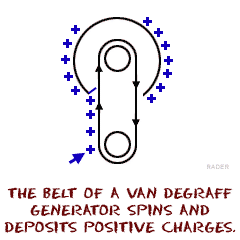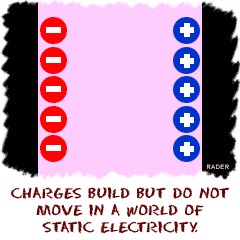Separating Charges
 Atoms start out with the same number of negative charges (electrons), and positive charges (protons).
Under certain conditions, electrons can be removed from, or added to
atoms. Removing electrons would leave the atom with more positives than
negatives, and we call this a positive ion (An ion is a charged atom).
Conversely, adding electrons to an atom would result in a negative ion.
If you do this enough times, you can make an object positive or
negative.
Atoms start out with the same number of negative charges (electrons), and positive charges (protons).
Under certain conditions, electrons can be removed from, or added to
atoms. Removing electrons would leave the atom with more positives than
negatives, and we call this a positive ion (An ion is a charged atom).
Conversely, adding electrons to an atom would result in a negative ion.
If you do this enough times, you can make an object positive or
negative.
Friction is one of the ways to separate charge. Have you ever had a science lab where you rub fur on glass rods, or try to make static cling? When you do that rubbing, you are actually rubbing electrons off one object and onto another. When you scuff your feet on the rug, especially in the winter, you can often charge yourself. Clothes tumbling in the dryer often cling together and crackle when you separate them. Lightning is produced, in part, because of air blowing over land. You can also use batteries to separate charge.
Static Charges
 Electrons can move more easily in some objects than in others. If you
put a charge on things like glass, plastic, rubber, and wood, that
charge stays where you put it. We say the charges are static, and we
call this static electricity.
Electrons can move more easily in some objects than in others. If you
put a charge on things like glass, plastic, rubber, and wood, that
charge stays where you put it. We say the charges are static, and we
call this static electricity. Materials like glass and plastic are called insulators, or nonconductors. Static electricity can happen on a dry winter day when you walk across a carpet. You are actually building up loads of electrons on your skin. Charges don't "want" to stay separated, however. There is always a tendency for charges to return to their original locations, and all that is needed is a pathway for charges (electrons) to use.
- When you touch a metal doorknob, for example, electrons can jump and give you a shock. Static charges build up on clouds until they can hold no more. At that point, lightning can occur. The study of electricity where the charges are not moving is called electrostatics.
Bewareof Conductors!
Beware

